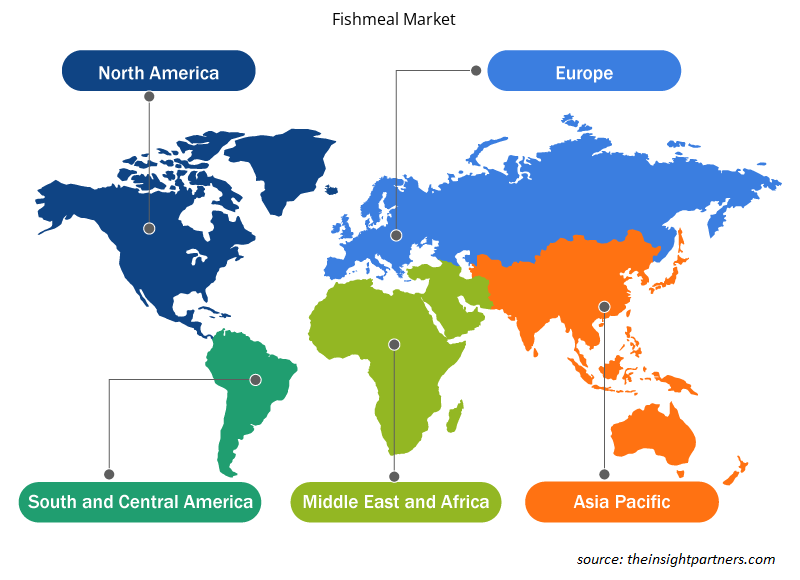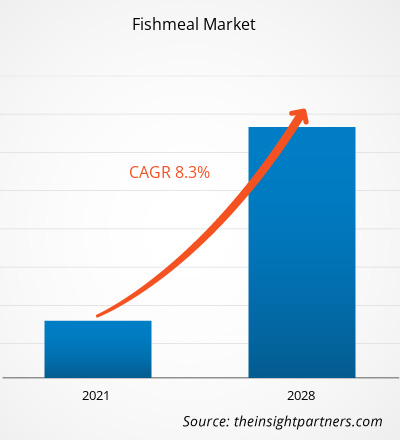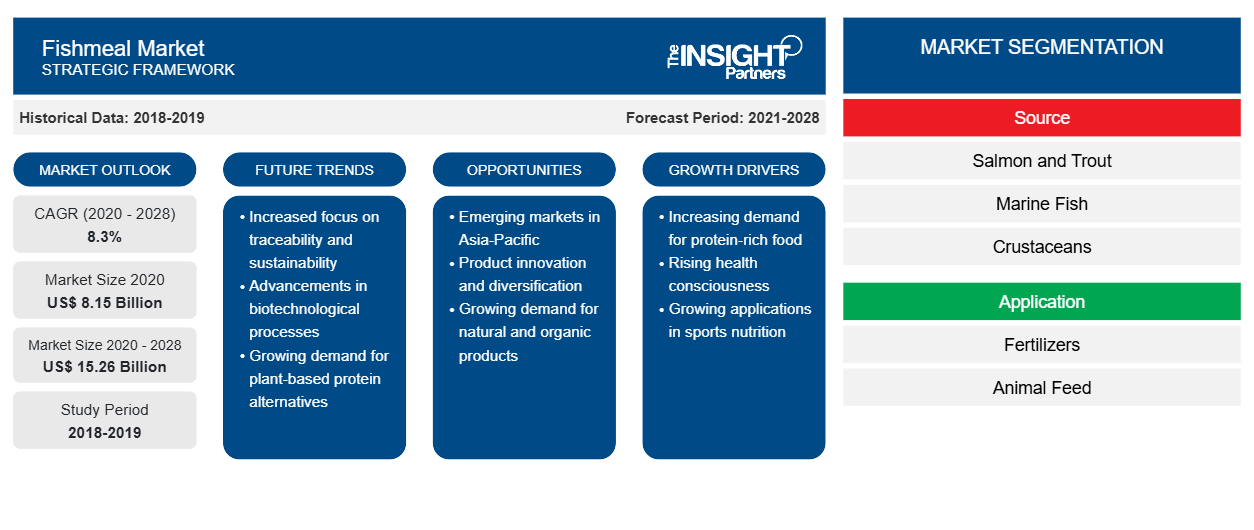Der Fischmehlmarkt hatte im Jahr 2020 einen Wert von 8.153,6 Millionen US-Dollar und soll bis 2028 einen Wert von 15.264,6 Millionen US-Dollar erreichen; von 2021 bis 2028 wird mit einer durchschnittlichen jährlichen Wachstumsrate von 8,3 % gerechnet.
Fischmehl wird aus Fischnebenprodukten der Lebensmittelverarbeitung und Filetierindustrie hergestellt. Es wird hauptsächlich als proteinreicher (60–72 %) Inhaltsstoff in Futtermitteln für Nutztiere und Aquakulturarten verwendet. Die Nachfrage nach Fischmehl übersteigt das Angebot; daher hat die Futtermittelindustrie die Zusammensetzung des Fischmehls in Futtermitteln erheblich verändert. Der Fischmehlmarkt hat im Laufe der Geschichte aufgrund der Entwicklung der Aquakultur aufgrund der steigenden Nachfrage nach Meeresfrüchten und der zunehmenden Abhängigkeit der Entwicklungsländer von der Aquakultur zur Lösung der Nahrungsmittelknappheit ein Wachstum erlebt. Außerdem ist Fischmehl von Natur aus nachhaltig, da es aus Abfallkomponenten anderer Industrien hergestellt wird. Daher ist es Teil verschiedener Umweltschutzprogramme. Der Markt profitiert dabei von nachhaltigen Praktiken wie dem ökologischen Landbau.
Im Jahr 2020 hatte der asiatisch-pazifische Raum den größten Umsatzanteil am globalen Fischmehlmarkt . Außerdem wird die Region im Prognosezeitraum voraussichtlich die höchste durchschnittliche jährliche Wachstumsrate verzeichnen. Der asiatisch-pazifische Raum umfasst mehrere große Volkswirtschaften wie Indien, China, Japan, Südkorea und Australien. Diese Länder erleben einen Aufschwung bei der Industrialisierung des Lebensmittelsektors und bei Urbanisierungsaktivitäten, was den wichtigsten Akteuren auf dem Fischmehlmarkt reichlich Gelegenheiten bietet . Im asiatisch-pazifischen Raum wird in den kommenden Jahren eine steigende Nachfrage nach Fischmehl erwartet , da zahlreiche kleine und mittlere inländische Akteure auf dem Markt vertreten sind. Im Prognosezeitraum wird der Fischmehlmarkt voraussichtlich eine enorme Nachfrage aus der Aquakultur- und Biolandwirtschaft verzeichnen, da er über ein sehr nahrhaftes Profil mit essentiellen Aminosäuren verfügt. Außerdem findet Fischmehl Verwendung in der Nutraceutika- , Pharma- und anderen Industrien. Der Fischmehlmarkt im asiatisch-pazifischen Raum wird im Prognosezeitraum voraussichtlich aufgrund des enormen Wachstums des Aquakultursektors, insbesondere in Indien und China, wachsen. Darüber hinaus treiben die steigende Bevölkerungszahl und die zunehmende staatliche Unterstützung das Marktwachstum in der Region voran.
Passen Sie diesen Bericht Ihren Anforderungen an
Sie erhalten kostenlos individuelle Anpassungen an jedem Bericht, einschließlich Teilen dieses Berichts oder einer Analyse auf Länderebene, eines Excel-Datenpakets sowie tolle Angebote und Rabatte für Start-ups und Universitäten.
-
Holen Sie sich die wichtigsten Markttrends aus diesem Bericht.Dieses KOSTENLOSE Beispiel umfasst eine Datenanalyse von Markttrends bis hin zu Schätzungen und Prognosen.
Die COVID-19-Pandemie hat sich durch Unterbrechungen der Lieferkette negativ auf die Fischereiindustrie ausgewirkt. Der Rückgang der Nachfrage nach Meeresfrüchten hat zu einer verringerten Fischproduktion geführt. Die geringe Nachfrage nach Fisch reduzierte die Aktivitäten der Fischereiflotte, was sich negativ auf die Produktion von Fischnebenprodukten, insbesondere Fischmehl , auswirkte . Mit dem Beginn der weltweiten Impfkampagnen erholen sich die Volkswirtschaften jedoch wieder und die Industrie verzeichnet eine Nachfrage nach ihren Produkten. Verschiedene Regierungen ergreifen außerdem Initiativen, um die Verluste der Fischereiindustrie aufgrund dieser Pandemie zu minimieren. Daher wird erwartet, dass der Fischmehlmarkt in den kommenden Jahren wachsen wird.
Markteinblicke
Steigende Nachfrage nach proteinreichem Tierfutter
Die Industrialisierung der Tierhaltung hat die Nachfrage nach proteinreichen Futterzutaten erhöht , um die Futterverwertung zu steigern. Industriell gezüchtetes Vieh wird hauptsächlich mit Konzentraten aus Getreide und pflanzlichen Proteinen wie Sojamehl gefüttert, um die Gewichtszunahme zu unterstützen und proteinreiches Fleisch zu produzieren. Nutztiere sind auf Proteine und andere Elemente als Bausteine angewiesen, die für ihr Wachstum unerlässlich sind. Proteine in Tierfutter sind eine ausgezeichnete Energiequelle und enthalten essentielle Aminosäuren wie Lysin und Methionin . Das wachsende Bewusstsein über die gesundheitlichen Vorteile von Proteinen für die Tiergesundheit hat eine erhebliche Nachfrage nach verschiedenen Proteinfuttermitteln wie tierischen Proteinmehlen, Federmehl, Fischmehl , Knochenmehl und Blutmehl geschaffen. Fischmehl ist eine reichhaltige Quelle für Proteine, Mineralien und Fettsäuren und wird vom Vieh beim Verzehr leicht verdaut. Hochwertiges Fischmehl ermöglicht die Zusammenstellung nährstoffreicher Tiernahrung und fördert deren optimales Wachstum. Da Nutztiere und Nutztiere einen bedeutenden Beitrag zur globalen Lebensmittelversorgungskette leisten, steigt die Nachfrage nach proteinreichem, nahrhaftem Tierfutter und wird im Prognosezeitraum voraussichtlich anhalten. Die ständig steigende Nachfrage nach proteinreichem Tierfutter zur Förderung des Wachstums von Nutztieren in allen Lebensphasen treibt den Fischmehlmarkt insgesamt erheblich an.
Quelle Einblicke
Der globale Fischmehlmarkt ist nach Herkunft in Lachs, Makrele, Sardelle, Lodde und andere unterteilt. Im Jahr 2020 machte das Sardellensegment den größten Umsatzanteil aus. Sardellen kommen hauptsächlich in SAM vor, insbesondere in Peru. Das Volumen der aus peruanischen Sardellen hergestellten Fischmehlproduktion entspricht dem Bedarf der Hälfte der weltweiten Produktion von gefüttertem Zuchtfisch. Der Markt für das Sardellensegment dürfte im Prognosezeitraum aufgrund der großen Verfügbarkeit von Sardellen in großen Mengen wachsen. Die hohe Verfügbarkeit von Sardellen wirkt sich auch positiv auf die globale Ernährungssicherheit aus.
Anwendungseinblicke
Basierend auf der Anwendung ist der globale Fischmehlmarkt in Tierfutter, Landwirtschaft und andere unterteilt. Im Jahr 2020 machte das Segment Tierfutter den größten Umsatzanteil aus. Fischmehl ist ein leicht verdaulicher Futterbestandteil mit einem hohen Energiegehalt pro Gewichtseinheit. Es enthält wenig Kohlenhydrate und ist eine ausgezeichnete Quelle für Vitamine, Mineralien, Öle (Lipide) und Proteine. Viele kommerzielle Fischmehle werden aus kleinen und knochigen Fischen hergestellt, die nicht für den menschlichen Verzehr geeignet sind, oder aus Nebenprodukten der Fischverarbeitungsindustrie. Daher macht die Aufwertung von Nebenprodukten das Fischmehl als Tierfutter wirtschaftlich. Daher treibt die Verbesserung von Tierfutter mit Hilfe von Fischmehl das Marktwachstum für dieses Segment voran.
TripleNine , The Scoular Company, FF SKAGEN A/S, Pelagia AS, Soytex LTD, Pesquera Diamante SA , TASA , Oceana Group Limited, Omega Protein Corporation und COPEINCA sind einige etablierte Akteure auf dem globalen Fischmehlmarkt . Unternehmen auf dem Markt verfolgen Strategien wie Produktentwicklungen, Werkserweiterungen sowie Fusionen und Übernahmen, um ihre Präsenz weltweit auszubauen und die wachsende Nachfrage der Endverbraucher zu befriedigen. So brachte Scoular im September 2021 für sein wachsendes Fischmehlgeschäft die neue Marke Encompass auf den Markt .
Regionale Einblicke in den Fischmehlmarkt
Die regionalen Trends und Faktoren, die den Fischmehlmarkt im Prognosezeitraum beeinflussen, wurden von den Analysten von Insight Partners ausführlich erläutert. In diesem Abschnitt werden auch die Fischmehlmarktsegmente und die Geografie in Nordamerika, Europa, im asiatisch-pazifischen Raum, im Nahen Osten und Afrika sowie in Süd- und Mittelamerika erörtert.

- Holen Sie sich die regionalspezifischen Daten zum Fischmehlmarkt
Umfang des Fischmehl-Marktberichts
| Berichtsattribut | Details |
|---|---|
| Marktgröße im Jahr 2020 | 8,15 Milliarden US-Dollar |
| Marktgröße bis 2028 | 15,26 Milliarden US-Dollar |
| Globale CAGR (2020 - 2028) | 8,3 % |
| Historische Daten | 2018-2019 |
| Prognosezeitraum | 2021-2028 |
| Abgedeckte Segmente |
Nach Quelle
|
| Abgedeckte Regionen und Länder |
Nordamerika
|
| Marktführer und wichtige Unternehmensprofile |
|
Dichte der Akteure auf dem Fischmehlmarkt: Auswirkungen auf die Geschäftsdynamik verstehen
Der Fischmehlmarkt wächst rasant, angetrieben durch die steigende Nachfrage der Endverbraucher aufgrund von Faktoren wie sich entwickelnden Verbraucherpräferenzen, technologischen Fortschritten und einem größeren Bewusstsein für die Vorteile des Produkts. Mit steigender Nachfrage erweitern Unternehmen ihr Angebot, entwickeln Innovationen, um die Bedürfnisse der Verbraucher zu erfüllen, und nutzen neue Trends, was das Marktwachstum weiter ankurbelt.
Die Marktteilnehmerdichte bezieht sich auf die Verteilung der Firmen oder Unternehmen, die in einem bestimmten Markt oder einer bestimmten Branche tätig sind. Sie gibt an, wie viele Wettbewerber (Marktteilnehmer) in einem bestimmten Marktraum im Verhältnis zu seiner Größe oder seinem gesamten Marktwert präsent sind.
Die wichtigsten auf dem Fischmehlmarkt tätigen Unternehmen sind:
- DreifachNeun
- Die Scoular Company
- FF SKAGEN A/S
- Pelagia AS
- Soytex LTD
Haftungsausschluss : Die oben aufgeführten Unternehmen sind nicht in einer bestimmten Reihenfolge aufgeführt.

- Überblick über die wichtigsten Akteure auf dem Fischmehlmarkt
Bericht-Spotlights
- Fortschrittliche Branchentrends auf dem globalen Fischmehlmarkt helfen den Akteuren bei der Entwicklung wirksamer langfristiger Strategien
- In Industrie- und Entwicklungsländern angewandte Strategien für Unternehmenswachstum
- Quantitative Analyse des globalen Fischmehlmarktes von 2019 bis 2028
- Schätzung der Nachfrage nach Fischmehl in verschiedenen Branchen
- Aktuelle Entwicklungen zum Verständnis des Wettbewerbsmarktszenarios und der Nachfrage nach Fischmehl
- Markttrends und -aussichten in Verbindung mit Faktoren, die das Wachstum des Fischmehlmarktes vorantreiben und bremsen
- Entscheidungsprozess durch das Verständnis von Strategien, die das kommerzielle Interesse im Hinblick auf das Wachstum des globalen Fischmehlmarktes untermauern
- Fischmehlmarktgröße an verschiedenen Knotenpunkten des Marktes
- Detaillierte Übersicht und Segmentierung des globalen Fischmehlmarktes sowie seiner Dynamik in der Branche
- Fischmehlmarktgröße in verschiedenen Regionen mit vielversprechenden Wachstumschancen
Fischmehlmarkt , nach Quelle
- Lachs
- Makrele
- Sardelle
- Lodde
- Sonstiges
Fischmehlmarkt , nach Anwendung
Firmenprofile
- DreifachNeun
- Die Scoular Company
- FF SKAGEN A/S
- Pelagia AS
- Soytex LTD
- Pesquera Diamante SA
- TASA
- Oceana Group Limited
- Omega Protein Corporation
- COPEINCA
- Historische Analyse (2 Jahre), Basisjahr, Prognose (7 Jahre) mit CAGR
- PEST- und SWOT-Analyse
- Marktgröße Wert/Volumen – Global, Regional, Land
- Branchen- und Wettbewerbslandschaft
- Excel-Datensatz
Aktuelle Berichte
Erfahrungsberichte
Grund zum Kauf
- Fundierte Entscheidungsfindung
- Marktdynamik verstehen
- Wettbewerbsanalyse
- Kundeneinblicke
- Marktprognosen
- Risikominimierung
- Strategische Planung
- Investitionsbegründung
- Identifizierung neuer Märkte
- Verbesserung von Marketingstrategien
- Steigerung der Betriebseffizienz
- Anpassung an regulatorische Trends























 Kostenlose Probe anfordern für - Fischmehlmarkt
Kostenlose Probe anfordern für - Fischmehlmarkt